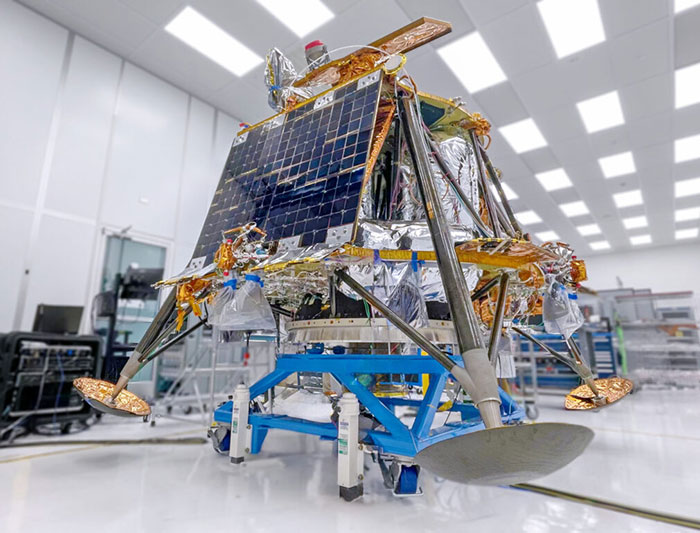“Unlocking the Secrets of the Moon: Witness History as NASA Broadcasts the First Commercial Lunar Launch Live!”
Hold onto your rocket chairs, folks, because this week brings an exhilarating moment in space exploration! NASA is gearing up to live stream a monumental event as Firefly Aerospace prepares to launch its inaugural mission to the moon. That’s right — we’re talking about the Blue Ghost mission, which is set to carry 10 NASA science investigations and groundbreaking technology demonstrations to help us crack the code of the Moon’s mysteries. It’s like sending a bunch of nerdy scientists to a celestial party! Scheduled for lift-off on January 15th from Florida’s Kennedy Space Center aboard a SpaceX Falcon 9 rocket, this event is a must-watch for space enthusiasts and curious minds alike. So, are you ready to see how the universe’s biggest rock gets a tech upgrade? You can catch all the action live on NASA’s website or YouTube, and don’t forget to register for virtual attendance to get those mission updates sent straight to your inbox. Get excited – space exploration is about to get a serious boost! LEARN MORE.
This week NASA will live streaming a historic event as Firefly Aerospace launches its first mission to the moon.
The Blue Ghost mission will carry 10 NASA science investigations and first-of-their-kind technology demonstrations to the lunar surface to further our understanding of the Moon’s environment.
Firefly Aerospace’s Blue Ghost Mission 1 will lift off on a SpaceX’s Falcon 9 rocket from Launch Complex 39A at the agency’s Kennedy Space Center in Florida on 15th of January.
The coverage of the mission will be available on the NASA website with live streaming on Youtube no earlier than 12:30 a.m. EST Jan. 15, as the countdown milestones occur.
NASA also invites people to register to attend this launch virtually here. All the registrants will receive mission updates and activities by email, including curated mission resources, schedule updates, and a virtual guest passport stamp.
Firefly’s Blue Ghost Mission 1 has 10 NASA payloads on board
Image credits: NASA
Image credits: fireflyspace
After spending 45 days in space traveling, the 2 meters tall and 3.5 meters wide lander is targeted to land in the Mare Crisium region, where it will operate on the Moon’s surface for about two weeks.
NASA collaborated with the Italian Space Agency, Blue Origin, various universities and research centers to deliver science and technology to the lunar surface through the Commercial Lunar Payload Services (CLPS) initiative.
10 payloads on this mission will help advance lunar research and conduct several first-of-their-kind technology demonstrations, as well as prepare for future crewed missions to the Moon as part of the NASA broader Artemis campaign.
Image credits: Firefly Aerospace
Image credits: Firefly Aerospace
X-ray images of Earth’s magnetosphere will provide critical insights about the interaction of solar wind and the Earth’s magnetic field to better inform weather predictions and other cosmic forces, GPS protection, and satellite connectivity.
Subsurface drilling, sample collection and analysis, and measuring local electromagnetic fields will help determine the Moon’s temperature structure and thermal evolution, as well as surface and interior composition and heat flow.
Other payloads will study how lunar dust cling to various materials and use electromagnetism to diminish or prevent abrasive regolith buildup on spacecraft, spacesuits, and habitats.
NASA is ready to explore of the Moon than ever before, awarding Firefly Aerospace $179 million
Image credits: Firefly Aerospace
The space transportation firm Firefly, which was founded in 2017 and is now valued at $2 billion, has been awarded four task orders to complete three lunar deliveries as part of NASA’s CLPS initiative.
“To have your name associated with a vehicle that’s going to land on the Moon and stay there is quite inspirational,” Firefly Aerospace’s CEO Jason Kim shared.
The 2nd Firefly’s lunar mission is scheduled in 2026 and includes a lunar orbit drop-off of a satellite and a surface delivery to the far side of the Moon while the 3rd will aim to deliver six NASA payloads to the Gruithuisen Domes on the Moon’s near side.
People on the internet couldn’t hold back their excitement about upcoming remarkable launch





































